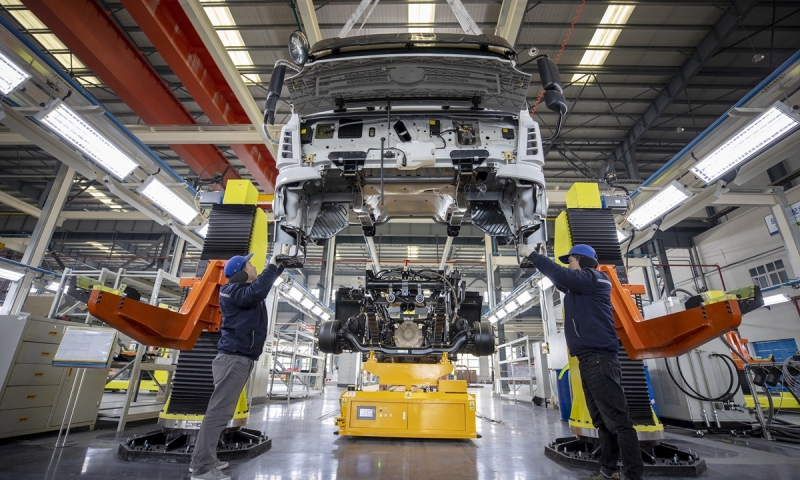战略院党委书记刘冬梅在环球时报(Global Times)发表署名文章:Chinese science and technology continue to advance despite increasing global technological nationalism

Employees of a commercial EV company in Yancheng, East China's Jiangsu Province, rush to complete orders. Photo: IC
Chinese science and technology have made rapid progress and significant achievements over past decades. While supporting the high-quality development of the domestic economy and leading the continuous upgrading of industries, Chinese science and technology endeavors have also made important contributions to world technology advancement. In the future, the prospects for the development of Chinese science and technology are being viewed as even brighter than past decades, and there will be more "Chinese elements" in the progress of world scientific and technological development.
The Global Innovation Index by the World Intellectual Property Organization and the National Innovation Index Report by the Chinese Academy of Science and Technology for Development both show that China's innovation capability has been rapidly improving in recent years. China's ranking in the Global Innovation Index has risen from 34th in 2012 to 12th in 2023. In the National Innovation Index Report, China's ranking has increased from 20th in 2012 to 10th in 2023.
The influence of Chinese scientific research continues to rise. In 2022, China published 360,000 high-level international journal articles, with a total of 649,600 citations, ranking first globally. China's intellectual property achievements are steadily increasing. In 2023, China's granted invention patents reached 921,000, with a total of 4.99 million valid invention patents.
China continues to produce significant technological innovations. New applications in the field of aerospace have been achieved. China successfully completed a mission to return samples from the moon. The domestically-produced C919 large passenger aircraft completed its first commercial flight. The BeiDou Navigation Satellite System (BDS) has officially become part of International Civil Aviation Convention (ICAO) standards, becoming a globally recognized satellite navigation system for civil aviation.
China's construction of science and technology innovation centers is being coordinated and promoted comprehensively. According to the Global Top 100 Science and Technology Cluster list released by the World Intellectual Property Organization, China was home to 24 science and technology clusters that featured in the global top 100 by 2023, marking an increase of 3 from the previous year, which positioned China as the country with the most science and technology clusters. Beijing, Shanghai, and the Guangdong-Hong Kong-Macao Greater Bay Area stand out as the three major international science and technology innovation centers, with their scientific strength entering the international leading ranks.
In recent years, China has been actively implementing the strategy of innovation-driven development, with scientific and technological innovation becoming a new driving force for economic transformation and upgrading, enhancing economic vitality.
According to data from the National Bureau of Statistics, in 2023, the value added of high-tech manufacturing in China increased by 2.7 percent, accounting for 15.7 percent of the value added of industrial enterprises above designated size, and investment in high-tech industries increased by 10.3 percent compared to the previous year.
China has vigorously promoted the development of digital economy, focusing on advancing industrial digital transformation and the development of digital industries. In 2022, the size of China's digital economy reached 50.2 trillion yuan ($6.95 trillion), with a nominal year-on-year growth of 10.3 percent.
China is an active participant in global climate governance, is focused on green and low-carbon international cooperation, and regards technological innovation as an important force to promote sustainable development. Currently, China is accelerating the construction of a new-energy system, with new-energy technologies represented by wind power, photovoltaics, new-energy storage, and new-energy vehicles showing great potential.
According to data from the National Energy Administration, by the end of 2023, China's installed capacity of solar power generation was about 610 million kilowatts, and the installed capacity of wind power was about 440 million kilowatts. Meanwhile, China's new-energy vehicle industry is also growing rapidly, with a production of 9.44 million new-energy vehicles in 2023, an increase of 30.3 percent over the previous year.
After decades of continuous efforts, China's science and technology has laid a solid foundation for future achievement. Faced with a new round of technological revolution and industrial transformation, China also has the ability to seize development opportunities and achieve a leap in scientific and technological strength.
The country's continuous large-scale investment in science and technology will produce significant cumulative effects, realizing the emergence of capabilities and a leap from quantitative to qualitative changes in scientific and technological innovation achievements. The total R&D expenditure in the whole society has increased from 1.03 trillion yuan in 2012 to 3.3 trillion yuan in 2023.
China has become the world's second-largest economy, with a complete and well-matched industrial system, being the only country in the world that has all the industrial categories listed in the UN industrial classification. This provides sufficient resource guarantee and application scenario support for scientific and technological innovation.
Currently, global technological nationalism is on the rise, led by the agenda of a few countries to block and suppress China's technology development. The world is facing severe risks and challenges of "decoupling" the innovation system, breaking the innovation chain, and reversing the trend of globalization.
Faced with this complex situation, China is adhering to the direction of globalization, adheres to the concept of international scientific and technological cooperation that is open, fair, just, and non-discriminatory, and further integrates deeply into the global innovation network.
The author is Party secretary of Chinese Academy of Science and Technology for Development (CASTED). bizopinion@globaltimes.com.cn
 联系我们
联系我们
地址:中国 北京市海淀区玉渊潭南路8号 邮编(ZIP):100038
电话(Tel):86-10-58884543 咨询:webmaster@casted.org.cn 新闻与信息:xxxz@casted.org.cn
![]() 版权所有 B体育sports官方网站 - B体育IOS版下载安装 备案号/经营许可证备号:京ICP备10036465号-11
技术支持:中研网
版权所有 B体育sports官方网站 - B体育IOS版下载安装 备案号/经营许可证备号:京ICP备10036465号-11
技术支持:中研网




